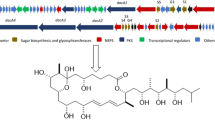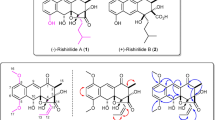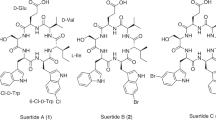Abstract
A southern Australian soil isolate, Amycolatopsis sp. MST-108494, was subjected to a panel of fermentation and media optimization trials, supported by analytical chemical profiling, to detect and enhance production of a rare class of secondary metabolites. Chemical fractionation of two complementary fermentations yielded three new polyketides, identified by detailed spectroscopic analysis as the glycosylated macrolactones, amycolatopsins A (1), B (2) and C (3), closely related to the ammocidins and apoptolidins. Amycolatopsins 1 and 3 selectively inhibited growth of Mycobacterium bovis (BCG) and Mycobacterium tuberculosis (H37Rv) when compared with other Gram-positive or Gram-negative bacteria, with 3 exhibiting low levels of cytotoxicity toward mammalian cells. Thus, our data reveal promising structure activity relationship correlations where the antimycobacterial properties of amycolatopsins are enhanced by hydroxylation of the 6-Me (that is, 1 and 3), whereas mammalian cytotoxicity is decreased by hydrolysis of the disaccharide moiety (that is, 3).
Similar content being viewed by others

Log in or create a free account to read this content
Gain free access to this article, as well as selected content from this journal and more on nature.com
or
Accession codes
References
Garcia, A., Bocanegra-Garcia, V., Palma-Nicolas, J. P. & Rivera, G. Recent advances in antitubercular natural products. Eur. J. Med. Chem. 49, 1–23 (2012).
World Health Organisation WHO treatment guidelines for drug- resistant tuberculosis, 2016 (ISBN 978 92 4 154963 9).
Stop TB Partnership The Global Plan to Stop TB, 2006-2015. actions for life: towards a world free of tuberculosis. Int. J. Tuberc. Lung Dis. 10, 240–241 (2006).
Kim, J. W., Adachi, H., Shin-Ya, K., Hayakawa, Y. & Seto, H. Apoptolidin, a new apoptosis inducer in transformed cells from Nocardiopsis sp. J. Antibiot. 50, 628–630 (1997).
Murakami, R. et al. Ammocidins B, C and D, new cytotoxic 20-membered macrolides from Saccharothrix sp. AJ9571. J. Antibiot. 62, 123–127 (2009).
Murakami, R. et al. Ammocidin, a new apoptosis inducer in Ras-dependent cells from Saccharothrix sp. I. Production, isolation and biological activity. J. Antibiot. 54, 710–713 (2001).
Murakami, R. et al. Ammocidin, a new apoptosis inducer in Ras-dependent cells from Saccharothrix sp. II. Physico-chemical properties and structure elucidation. J. Antibiot. 54, 714–717 (2001).
Wender, P. A., Sukopp, M. & Longcore, K. Apoptolidins B and C: isolation, structure determination, and biological activity. Org. Lett. 7, 3025–3028 (2005).
Wender, P. A. & Longcore, K. E. Apoptolidins E and F, new glycosylated macrolactones isolated from Nocardiopsis sp. Org. Lett. 11, 5474–5477 (2009).
Wender, P. A. & Longcore, K. E. Isolation, structure determination, and anti-cancer activity of apoptolidin D. Org. Lett. 9, 691–694 (2007).
Hayakawa, Y., Kim, J. W., Adachi, H., Shin-ya, K., Fujita, K. & Seto, H. Structure of apoptolidin, a specific apoptosis inducer in transformed Cells. J. Am. Chem. Soc. 120, 3524–3525 (1998).
Wender, P. A., Gulledge, A. V., Jankowski, O. D. & Seto, H. Isoapoptolidin: structure and activity of the ring-expanded isomer of apoptolidin. Org. Lett. 4, 3819–3822 (2002).
Chau, S. T., Sulikowski, G. A. & Wu, B. Studies on the synthesis of the apoptolidins. Strategies and Tactics in Organic Synthesis 8, 375–394 (2012).
Sheng, Y. et al. Succinylated apoptolidins from Amycolatopsis sp. ICBB 8242. Org. Lett. 17, 2526–2529 (2015).
Serrill, J. D. et al. Apoptolidins A and C activate AMPK in metabolically sensitive cell types and are mechanistically distinct from oligomycin A. Biochem. Pharmacol. 93, 251–265 (2015).
Lacey, E. & Tennant, S. Secondary metabolites - the focus of biodiscovery and perhaps the key to unlocking new depths in taxonomy. Microbiol. Aust. 24, 34–35 (2003).
Carmichael, J., DeGraff, W. G., Gazdar, A. F., Minna, J. D. & Mitchell, J. B. Evaluation of a tetrazolium-based semiautomated colorimetric assay: assessment of chemosensitivity testing. Cancer Res. 47, 936–942 (1987).
Henrich, C. J. et al. A high-throughput cell-based assay for inhibitors of ABCG2 activity. J. Biomol. Screen. 11, 176–183 (2006).
Acknowledgements
We thank AE Lacey (MST) for assistance with the metabolite purification. We acknowledge support from the University of Queensland Institute for Molecular Bioscience and University of Queensland Diamantina Institute. This research was funded in part by The University of Queensland (UQECR1607045).
Author contributions
EL, AC and DV were responsible for the cultivation and isolation of amycolatopsins. ZGK acquired, tabulated and interpreted all spectroscopic data, carried out all bioassays and assembled the Supplementary Information. AAS reviewed all NMR data. AB had oversight of all mycobacterial studies. RJC initiated the research program, and had oversight of all chemical studies and drafting of the manuscript. All authors have given approval to the final version of the manuscript.
Author information
Authors and Affiliations
Corresponding author
Ethics declarations
Competing interests
The authors declare no conflict of interest.
Additional information
Supplementary Information accompanies the paper on The Journal of Antibiotics website
Supplementary information
Rights and permissions
About this article
Cite this article
Khalil, Z., Salim, A., Vuong, D. et al. Amycolatopsins A–C: antimycobacterial glycosylated polyketide macrolides from the Australian soil Amycolatopsis sp. MST-108494. J Antibiot 70, 1097–1103 (2017). https://doi.org/10.1038/ja.2017.119
Received:
Revised:
Accepted:
Published:
Issue date:
DOI: https://doi.org/10.1038/ja.2017.119
This article is cited by
-
Suertides A–C: selective antibacterial cyclic hexapeptides from Amycolatopsis sp. MST-135876v3
The Journal of Antibiotics (2022)


